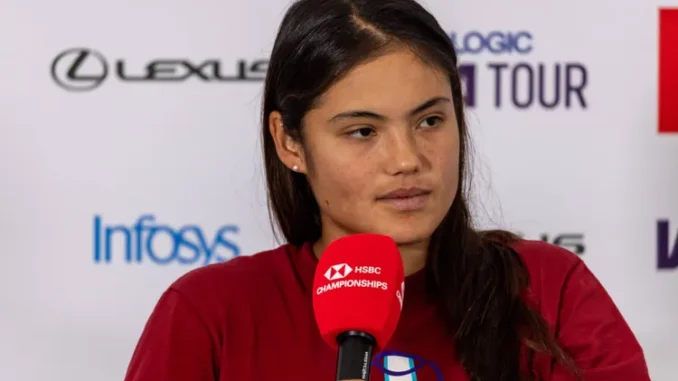
In a dramatic third-round clash at Wimbledon 2025, Emma Raducanu, Britain’s former US Open champion, faced a heart-wrenching defeat to world number one Aryna Sabalenka, falling 7-6(8-6), 6-4 in a match that showcased her resilience but also sparked controversy. The 22-year-old, who had electrified fans with earlier victories over Mingge Xu and 2023 champion Markéta Vondroušová, found herself at odds not only with her formidable opponent but also with Wimbledon’s newly implemented electronic line calling (ELC) system. Raducanu’s outspoken criticism of the technology, which she labeled “dodgy,” has ignited a broader debate about the reliability of automated officiating in tennis, echoing sentiments from fellow players and stirring nostalgia for the tournament’s traditional human line judges.
This year marked a historic shift for Wimbledon, as the All England Club replaced its iconic line judges with the Hawk-Eye Live system, a fully automated technology designed to enhance accuracy and streamline officiating. The move, aligning Wimbledon with other major tournaments like the US Open and Australian Open, was heralded by organizers as a step toward precision, with tournament director Jamie Baker asserting, “The concept of live line calling is absolutely standard across the tour now.” Yet, for Raducanu, the system’s debut was marred by errors that she believes cost her crucial points in her tightly contested match against Sabalenka. One moment in particular, during the first set at 2-4, 15-0, stood out: a Sabalenka serve, which Raducanu insisted was “for sure out,” was called in by the ELC. The call led to a short return from Raducanu, which Sabalenka capitalized on with a forehand winner, shifting momentum in a pivotal game. “It’s kind of disappointing, the tournament here, that the calls can be so wrong,” Raducanu said in her post-match press conference, her voice heavy with frustration. “For the most part they’ve been OK, but I’ve had a few in my other matches, too, that have been very wrong. Hopefully they can fix that.”
Raducanu’s concerns were not isolated to her match against Sabalenka. She noted similar issues in her earlier rounds, suggesting that the ELC’s inaccuracies were a recurring problem. Asked directly if she trusted the system, she was unequivocal: “No, I don’t trust the line calls – I think the other players would say the same thing, there were some pretty dodgy ones but what can you do?” Her words reflect a broader sentiment among players, including British men’s number one Jack Draper, who, after his second-round loss to Marin Cilic, remarked, “I don’t think it’s 100% accurate, in all honesty. A couple of the ones today it showed a mark on the court. There’s no way the chalk would have showed.” Even world number two Carlos Alcaraz expressed doubts during his third-round win, telling the umpire, “I’m not sure about some calls.”
The transition to ELC has not only raised questions about accuracy but also about the sensory experience of the game. Raducanu noted that the automated calls were often too quiet, especially on Centre Court, where the closed roof and roaring crowd drowned out the system’s audio cues. This lack of clarity added to the players’ frustration, as they struggled to hear calls in real time. The absence of human line judges, once a hallmark of Wimbledon’s tradition, also struck a chord with Raducanu, who lamented, “It’s a shame that the tradition’s kind of been broken with the linesmen and women.” She reminisced about the days when players could challenge calls using Hawk-Eye reviews, which she believed were “way more accurate” when paired with human oversight.
Despite the controversy, Raducanu’s performance against Sabalenka was a testament to her growing prowess. She saved seven match points in a gripping first-set tiebreak and pushed the top seed to her limits, earning praise from Sabalenka, who said, “Emma played such incredible tennis and she pushed me really hard to get this win. I had to fight for every point.” Raducanu’s ability to go toe-to-toe with one of the world’s best, despite questionable calls, highlighted her resilience and potential, even as her Wimbledon campaign ended in the third round.
The debate over ELC extends beyond Wimbledon, with Raducanu noting similar issues at other tournaments using the technology. While the ATP Tour and many WTA events have embraced automation, the French Open remains a holdout, sticking to human line judges. Wimbledon’s operations director, Michelle Dite, acknowledged player feedback about the system’s sound levels and said efforts were underway to optimize it, but the tournament has yet to address concerns about accuracy directly. As Raducanu prepares for the North American hardcourt swing, her critique of ELC underscores a pivotal moment for tennis, where the balance between tradition and technology remains a contentious issue. For now, her call for improvements resonates with players and fans alike, as the sport navigates this new era of officiating.
Leave a Reply